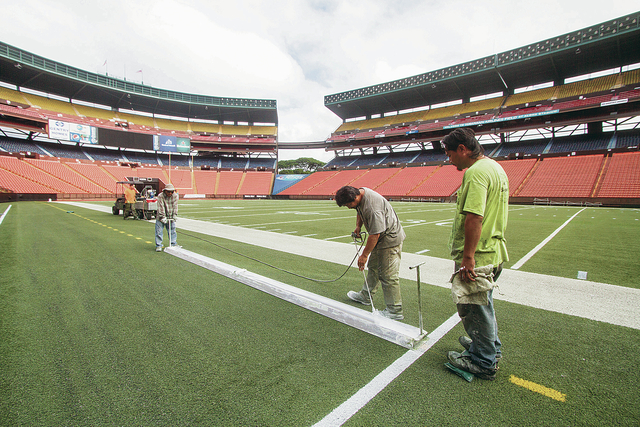After being shackled for nearly a half-century by deed restrictions, the way could be opened shortly for Aloha Stadium to help fund its future through public-private development.
The overdue breakthrough in a more than 20-year process to lift the deeds would come as the 41-year-old increasingly-costly-to-operate facility reaches what a city-commissioned report last year termed, “the end of its useful economic life.”
Next week the Honolulu City Council’s Budget Committee is scheduled to vote on a resolution that would lift half of the 49-year-old restriction against commercialization of the property. If approved, the measure would go to the full council April 20.
“This (resolution) is critical in the redevelopment of the Aloha Stadium property,” Council Chair Ernie Martin said Wednesday.
The other half of the restriction, held by the federal government since 1967, took a big step toward resolution earlier this month with the opening of the first stages of the 65-acre Central Maui Regional Sports Complex adjacent to the Wailea development.
When a stadium was first envisioned in Halawa, the city secured 56 acres from the U.S. Department of the Interior for $1.5 million with the understanding that it would be used for recreational pursuits. When the city backed away from the project three years later, transferring the land to the state, it attached its own restriction.
Though the parcels account for just over half of the 100 acres the facility sits on, with the restrictions the state has been unable to partner with commercial interests.
The deed restriction has permitted concerts, the Pro Bowl, the swap meet and other events considered “recreational,” according to officials, but has prohibited commercial development.
In 2009 the feds and state reached an understanding on the possibility of a land swap-to-be-named later in order to relieve the deed restriction, which is where the Central Maui facility eventually came in.
A trade-off with the city has yet to be brokered but could involve the planned HART station at Aloha Stadium. So far the Stadium Authority has only granted HART access to build rail guide-ways.
As bills for maintaining the stadium have mounted — a study estimated it would cost $200 million in 2014 dollars just to address priority health and safety concerns to keep it operational for another 30 years — officials have increasingly cast an eye toward mixed-use development.
Hawaii has enviously looked at national models that often include shops, restaurants, hotels and other development.
The Stadium Authority last year circulated a non-binding Request for Interest to developers seeking suggestions on how the property might be redeveloped.
A spokesman would not identify the five respondents but said they represented, “some of the top firms in the (stadium construction) industry,” with local partners.
The next step, a Request for Proposals solicitation, is planned for this year, state authority willing.
Meanwhile, the clock ticks and the costs climb on the aging “Rust Palace.”
Reach Ferd Lewis at flewis@staradvertiser.com or 529-4820.

